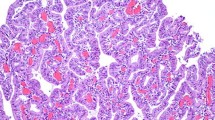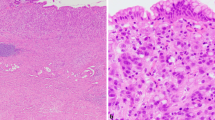Summary
Signet-ring-cell carcinomas were induced in the stomach of 12 beagle dogs by p.o. administration ofN-ethyl-N′-nitro-N-nitrosoguanidine (ENNG), and the morphology and modes of cell proliferation in an incipient stage of cancer growth were studied with bromodeoxyuridine (BrdUrd) incorporation. From 5 to 27 months after the completion of 8 months' carcinogen treatment, minute carcinomas were found in the stomachs of 9 dogs. Before sacrifice, the dogs were given a single or repeated i.v. injections of BrdUrd for 1–3 days. Minute signet-ring-cell carcinomas were found to form a layered structure, in which the cancer cells proliferated in the lamina propria at the gland-neck level and differentiated to postmitotic signet-ring cells at the upper and lower levels of the mucosa. From repeated injections of BrdUrd, the time required for all the proliferative cells to be labelled with BrdUrd (reflecting the maximum cellcycle time) was estimated to be 1.7 days for the normal glands, and 2.7 days for minute signet-ring-cell carcinomas. From the labelling index with BrdUrd as well as from the morphology, earliest carcinomas were identified in the single gland. There remained atrophic normal epithelium commonly in the single-gland lesions. Proliferative atypical cells appeared to be shed into the stroma passively through the atrophy and subsequent collapse of the gland rather than through active invasion. This may be a reason why cancer cells in minute signet-ring cell carcinomas preserved the normal pattern of cell renewal movement to form the layered structure.
Similar content being viewed by others
Abbreviations
- ENNG:
-
N-ethyl-N′-nitro-N-nitrosoguanidine
- BrdUrd:
-
bromodeoxyuridine
- LI:
-
labelling index
- t c :
-
cell cycle time
- t s :
-
duration of DNA synthetic phase
References
Banningan J, Langman J (1979) The cellular effect on 5-bromodeoxyuridine on the mammalian embryo. J Embryol Exp Morphol 50:123–135
Bleiberg H, Salhadin A, Galand P (1977) Cell cycle parameters in human colon. Comparison between primary and recurrent adenocarcinomas, benign polyps and adjacent unaffected mucosa. Cancer 39:1190–1194
Clarkson B, Ota K, Ohkita T, O'Conner A (1965) Kinetics of proliferation of cancer cells in neoplastic effusion in man. Cancer 18:1189–1213
Gratzner HG, Pollack A, Ingram DJ, Leif RC (1976) Deoxyribonucleic acid replication in single cells and chromosomes by immunologic techniques. J Histochem Cytochem 24:34–39
Grundmann E, Schlake W (1982) Histological classification of gastric cancer from initial to advanced stages. Pathol Res Pract 173:260–274
Hattori T (1986) Development of adenocarcinomas in the stomach. Cancer 57:1528–1534
Hattori T, Fujita S (1976) Tritiated thymidine autoradiographic study of cell migration and renewal in the pyloric mucosa of golden hamsters. Cell Tissue Res 175:49–57
Hattori T, Helpap B, Gedigk P (1984) Cell proliferation and growth of gastric carcinoma induced in inbred Wister rats byN-methylN′-nitro-N-nitrosoguanidine. Cancer Res 44:5266–5272
Hsu S-M, Reine L, Fanger H (1981) Use of avidin-biotin-peroxidase complex (ABC) in immunoperoxidase techniques: a comparison between ABC and unlabelled antibody (PAP) procedures. J Histochem Cytochem 29:577–580
Kurihara M, Shirakabe H, Izumi T, Miyasaka K, Yamaya F, Maruyama T, Yasui A (1977) Adenocarcinomas of the stomach induced in beagle dogs by oral administration of N-ethyl-N′-nitro-N-nitrosoguanidine. Z Krebsforsch 90:241–252
Kusakabe M, Yokoyama M, Sakakura T, Nomura T, Hosick HL, Nishizuka Y (1988) A novel methodology for analysis of cell distribution in chimeric mouse using a strain specific antibody. J Cell Biol 107:257–265
Lipkin M, Sherlock P, Bell B (1963) Cell proliferation kinetics in the gastrointestinal tract of man. Gastroenterology 45:721–729
Nakamura K, Sugano H, Takagi K (1968) Carcinoma of the stomach in incipient phase: its histogenesis and histological appearances. GANN 59:251–258
Sugihara H, Tsuchihashi Y, Hattori T, Fukuda M, Fujita S (1985) Cell proliferation and cell loss in intramucosal signet ring cell carcinomas of canine stomachs induced byN-ethyl-N′-nitro-Nnitrosoguanidine. J Cancer Res Clin Oncol 110:87–94
Sugihara H, Hattori T, Fukuda M (1986) Immunohistochemical detection of bromodeoxyuridine in formalin-fixed tissues. Histochemistry 85:193–195
Sugihara H, Hattori T, Fukuda M, Fujita S (1987) Cell proliferation and differentiation in intramucosal and advanced signet ring cell carcinomas of the human stomach. Virchows Arch [A] 411:117–127
Sugihara H, Hattori T, Fujita S, Fukuda M (1989) Distribution of fibronectin and laminin in early and advanced signet-ring-cell carcinomas of the stomach. Int J Cancer 43:263–269
Taki K, Kuwabara N (1981) Studies on histogenesis of the gastric carcinoma using minute cancers. Pathol Res Pract 172:176–190
Watanabe H, Hirose F, Takizawa S, Terada Y, Fujii I, Ohkita T (1979) A mode of incipient growth in chemically induced signet ring cell carcinoma of the canine stomach. Pathol Res Pract 164:216–223
Author information
Authors and Affiliations
Additional information
This work was supported by Grants-in Aid for Cancer Research from the Ministry of Education. Science and Culture, Japan.
Rights and permissions
About this article
Cite this article
Sugihara, H., Hattori, T., Imamura, Y. et al. Morphology and modes of cell proliferation in earliest signet-ring-cell carcinomas induced in canine stomachs byN-ethyl-N′-nitro-N- nitrosoguanidine. J Cancer Res Clin Oncol 117, 197–204 (1991). https://doi.org/10.1007/BF01625425
Received:
Accepted:
Issue Date:
DOI: https://doi.org/10.1007/BF01625425




